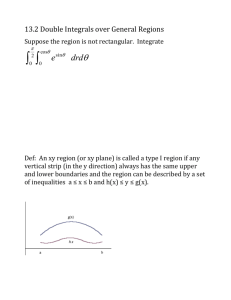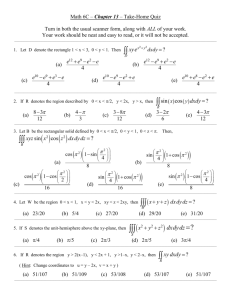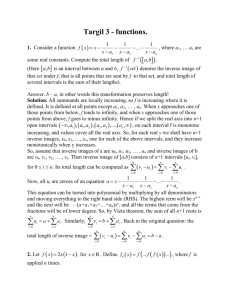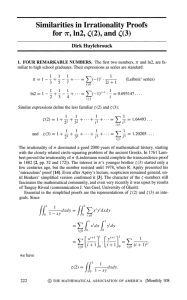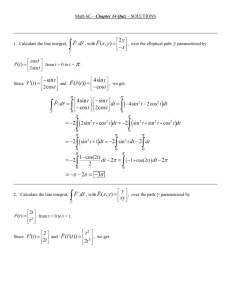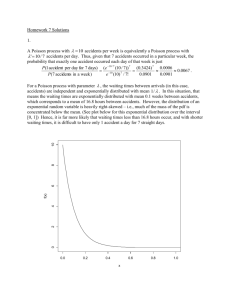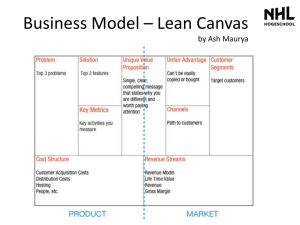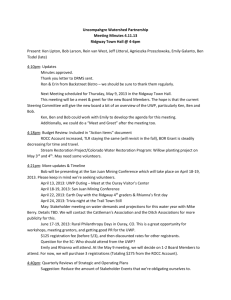Introduction - UCLA Department of Mathematics
advertisement
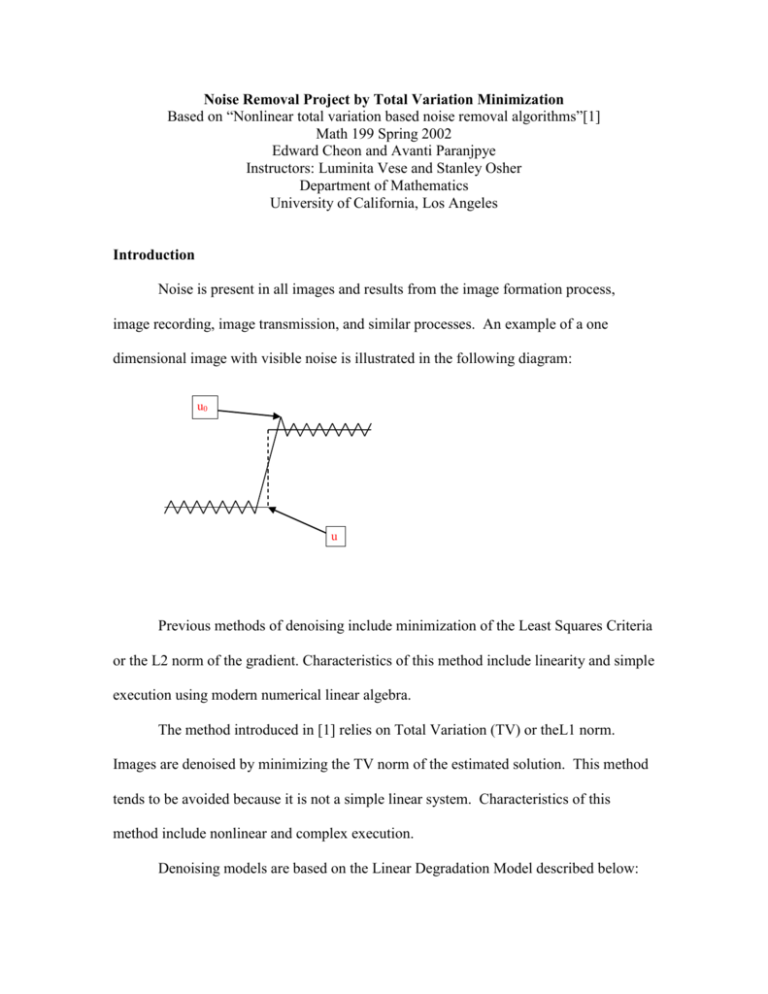
Noise Removal Project by Total Variation Minimization Based on “Nonlinear total variation based noise removal algorithms”[1] Math 199 Spring 2002 Edward Cheon and Avanti Paranjpye Instructors: Luminita Vese and Stanley Osher Department of Mathematics University of California, Los Angeles Introduction Noise is present in all images and results from the image formation process, image recording, image transmission, and similar processes. An example of a one dimensional image with visible noise is illustrated in the following diagram: u0 u Previous methods of denoising include minimization of the Least Squares Criteria or the L2 norm of the gradient. Characteristics of this method include linearity and simple execution using modern numerical linear algebra. The method introduced in [1] relies on Total Variation (TV) or theL1 norm. Images are denoised by minimizing the TV norm of the estimated solution. This method tends to be avoided because it is not a simple linear system. Characteristics of this method include nonlinear and complex execution. Denoising models are based on the Linear Degradation Model described below: uo(x,y) = u(x,y) + n(x,y), where: uo(x,y) = noisy image u(x,y) = clear image n(x,y) = additive noise Minimization Problem Minimization problems for noise removal assume that the mean of the noise is 0. i.e.: n(x,y)dxdy = 0 where = [0,a]x[0,b] Since the mean of the noise n(x,y) is 0, and integrating both sides over in the Linear Degradation Model uo = u + n, or uo – u = n we obtain uo = u. Using the standard deviation of noise, which shows the intensity of the noise let: n2 = 2 Therefore, (uo – u)2 = n2 = 2 (1) Now take the local averaging around the image except at the boundary, which causes blurring. In general, the definition of averaging leads to: u(t,x,y) = u(0,x,y) = uo (x,y) at t=0 du/dt = u = uxx + uyy Note: uxx + uyy is the Laplace equation, which has a strong smoothing effect. e.g.: for t=0: for t=Δt: for t=2 Δt: Previous methods have tried to minimize: Min F(u) = ½ (ux2 + uy2)dxdy Taking the derivative, we obtain the Laplace equation, which smoothes the image beyond recognition: du/dt = u = uxx + uyy ie: diagram with t=2t. From this, we see that if there is a large jump (gradient), it includes the jump in the average, causing the smoothing. To overcome this smoothing problem, we introduce a limit of averages: Let M be a bound. Looking at the image, we want to take the local average only where the |derivative of uo(x)| M Using our example: |uo’(x1)| M |uo’(x2)| >> M |uo’(x3)| M x1 x2 x3 In essence, we’ve changed the problem of minimizing F(u) to: F(u) = (ux2 + uy2)1/2 dxdy (2). This new method combines the previous linear method constraint (1) with the nonlinear constraint (2) giving us: Min F(u) = (uo – u)2 dxdy +(ux2 + uy2)1/2 dxdy Note that is the Lagrange Multiplier, the parameter coefficient which weighs how much smoothing we have. Now since we are minimizing F(u), we take the derivative of F, which gives: F’(u) = 0 => (u-uo) = d/dx ( ux/ (ux2 + uy2)1/2 ) + d/dy ( uy/ (ux2 + uy2)1/2 ) (3) Letting the gradient = |u| = (ux2 + uy2)1/2: If the gradient is 1, then we obtain the Laplace equation: (d/dx (ux) + d/dy (uy)) If the gradient is large >>1, then each term goes to 0. The Numerical Scheme This formula has the same form as (3) b/c it utilizes an iterative method/scheme, which can be step up with the following criteria: Where each position on the graph is represented by an element of a m x n matrix (ui,j) = [u11…..u1n un1…..unn] Each (i,j) = pixel = discrete points. uij = intensity of light at each point (i,j) on a gray scale where 0(black)<uij<255 (white). From this we know that the image = function. (x,y) u(x,y) on the domain . Now let h = space step = x = y. Let (xo,yo) = (0,0). xi = i*h, yj = j*h (discrete form) u(xi, yj) = u(i*h, j*h) = uijh Therefore, obtaining (3). Results We used the two dimensional denoising algorithm of [1] on the following images. To provide a contrast and to grasp a better understanding of the difference between previous mevthods involving the least squares criteria and the method involved total variation, we have provided the results of applying previous methods. image [a] is the original noisy image Between the methods of Total Variation and Least Squares criteria, we decided to work with the Total Variation method and minimize the function: Min F(u) = (uo – u) 2 dxdy + (ux2 + uy2) 1/2 dxdy In order to denoise the noisy image, we used the theory above in order to write an algorithm that could be utilized practically. In the algorithm, to produce the total variation image, we used the method described above and introduced in [1]. image [b] created with parameters: lambda = 0.01, iterations = 500 To compare the total variation method with other methods, we manipulated the least squares criteria and minimize the function: Min F(u) = |uo – u| dxdy + (ux2 + uy2) 1/2 dxdy. Because the absolute value function |.| is not differentiable in 0, we regularize the above functional using a small parameter = 0.000001, as follows: Min F(u) = [(uo – u)2 + 2] 1/2 dxdy + (ux2 + uy2 + 2 )1/2 dxdy. Here we can see that although most of the noise has been taken out, the corners of the objects in the image are slightly rounded and some blurring does occur. image [c] created with parameters: lambda = 0.1, iterations = 500 To produce another image of comparison we once again manipulate the least squares criteria and minimized the function: Min F(u) = [ (uo – u)2 dxdy] 1/2 + (ux2 + uy2) 1/2 dxdy. Because the involved functions are not differentiable in zero, again we introduce a small parameter (to avoid division by zero after differentiation), as follows: Min F(u) = [ 2 + (uo – u)2 dxdy] 1/2 + (ux2 + uy2+ 2 )1/2 dxdy. After experimenting the parameters lambda and the number of iterations, although the image somewhat less noisy, it is still not clear (image [d]). We have tried increasing and decreasing the value of lambda as well as the number of iterations. image [d] created with parameters: lambda = 112, iterations = 500 Works Cited [1] L.I. Rudin, S. Osher and E. Fatemi, “Nonlinear total variation based noise removal algorithms”, Physica D 60 pp. 259-268 (1992)
